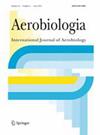Counting sedimented Betula pollen grains by gas chromatography coupled with mass spectrometry
Abstract
Birch pollen grains (BPGs) are major aeroallergens in Europe, causing allergies in millions of people. Although background concentrations are provided by stationary pollen monitoring stations, they do not accurately reflect personal exposure. Knowing personal exposure makes it possible to establish a link between inhaled pollen grains and symptoms. Characterizing personal exposure to pollen using portable devices is challenging and requires time-consuming visual counting of pollen grains. We have developed a method for counting sedimented BPGs based on easy sampling using a handheld hoover and automated analysis by gas chromatography-mass spectrometry (GC-MS). This work is a feasibility study on the use of a lipid tracer (heptacosane) for the mass quantification of sedimented BPGs in outdoor and indoor environments. Before a lipid tracer could be used for the determination of BPGs, we ensured that the variability of total lipid mass was low (around 17%) for pollen samples from various geographical origins and for several pollen seasons. The limit of quantification of sedimented BPGs by GC-MS was estimated to be 100 µg (equivalent to 16,000 BPGs), i.e. about 1.6 BPG cm−2 for a sampled surface of 1 m2. This method of assessing individual exposure was implemented during the birch pollen season indoors (between 70 and 225 sedimented BPGs per cm2) and outdoors, directly on the ground under a birch tree (over 6600 BPGs per cm2). This method of counting sedimented pollen grains is suitable for large sample series, and the data obtained could be used as an indicator of individual exposure to indoor air pollen in a large number of patients as part of epidemiological surveys.

 求助内容:
求助内容: 应助结果提醒方式:
应助结果提醒方式:


